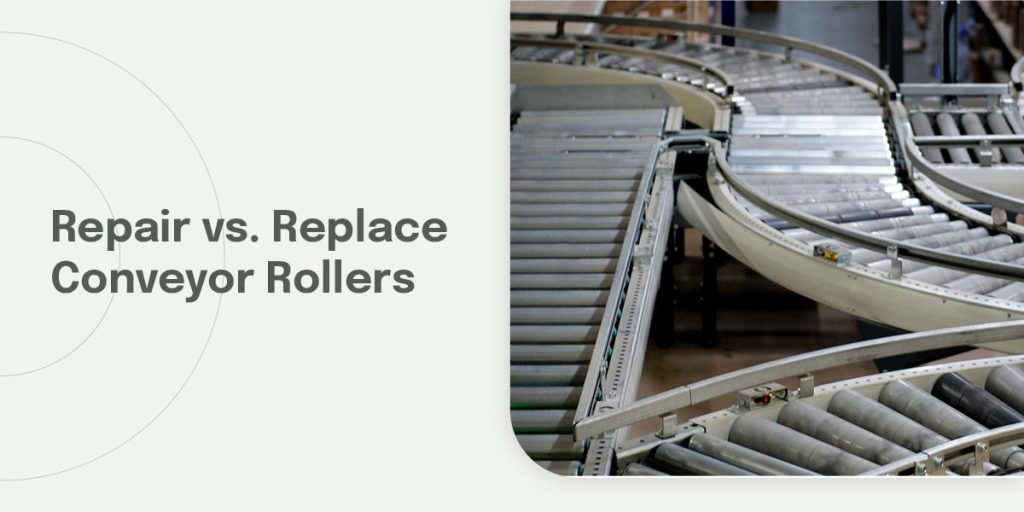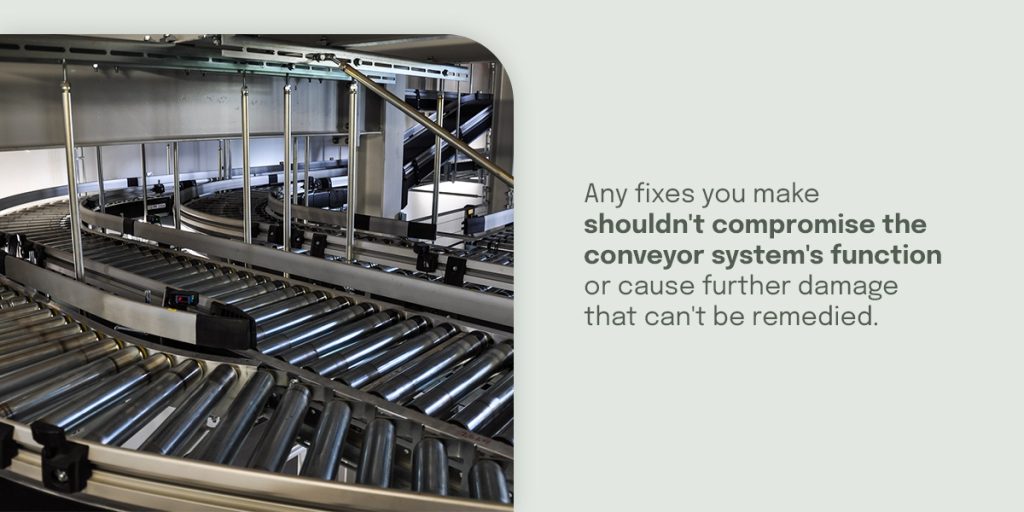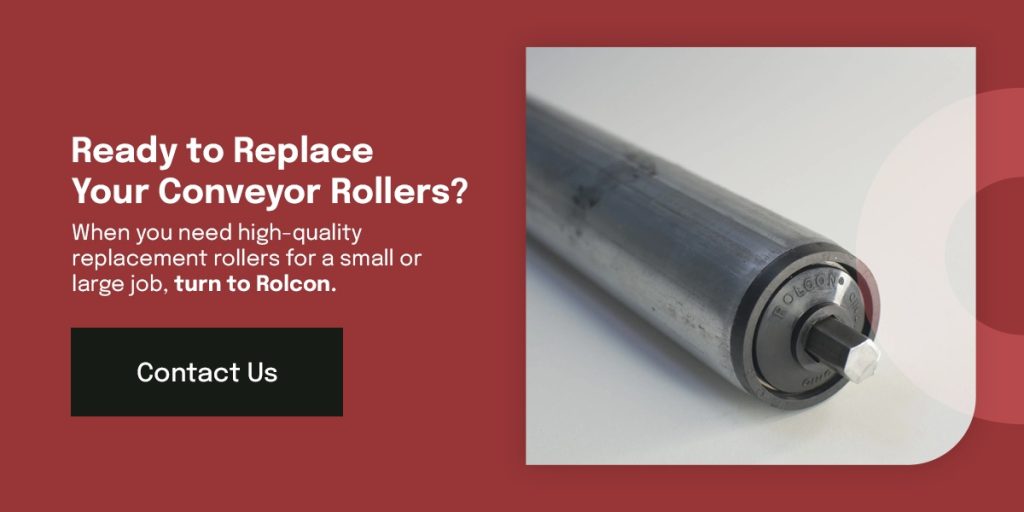
Over time, your conveyor systems’ components will wear down and require repairs or replacement, including your conveyor rollers. When that happens, you’ll need to ask yourself some questions — is it better to replace your conveyor rollers or have them repaired?
Below, learn more about how to recognize signs of wear and tear in your rollers and when it may be time to repair or replace them.
Signs Your Conveyor Rollers Need Attention
Performing regular roller upkeep and making adjustments when needed keeps your operations efficient and maintains your overall productivity. Part of the process is knowing when your conveyor systems require attention outside of the usual maintenance requirements.
Look for the following signs to know when you should start considering replacing or repairing your rollers:
- Regular maintenance intervals: Your conveyor rollers may need attention as part of a regular maintenance interval. During these inspections, you may find signs of wear and tear you wouldn’t normally notice during operation. The severity of the damage can indicate it’s time for a roller repair or replacement.
- Constant maintenance needs: In contrast to the above point, your rollers might require more maintenance than is normal as you experience increased component failures. This situation is a clear sign that your system components require further help than just the scheduled upkeep and associated tasks — upgrading your components may be necessary.
- Frame wear: If the roller frame is starting to show wear, it’s time to replace it. Conveyor systems used in industries such as aggregate and bulk material handling can see significant roller and frame damage due to lumps in the material or excessive amounts of material.
- Roller malfunctions: You may begin to encounter problems with your conveyor systems, such as rollers that don’t spin freely, conveyor belt failures or chain issues. When you start seeing component malfunctions like seized-up rollers, it’s best to replace these parts.
Other roller replacement indicators may arise that don’t necessarily involve malfunctions. For example, it may become harder to find spare parts for older conveyor systems, or outdated conveyor technology may begin to fall behind and affect your efficiency.
When to Repair Conveyor Rollers
Not every conveyor roller issue will require replacement, but it’s essential to weigh all relevant considerations when choosing the repair route. If the following points are applicable to your situation, you might choose to go ahead with repairs:
- Repairs won’t permanently damage the machinery: Any fixes you make shouldn’t compromise the conveyor system’s function or cause further damage that can’t be remedied. This point also applies to any temporary repairs you perform as you wait for a professional repair team or a set of replacement rollers.
- The machinery will still be safe for use: If you decide to repair vs. replace conveyor rollers, the machinery should still be safe for all employees to use after the fix. Any remedy that could potentially pose a safety risk to operators shouldn’t be performed, and a replacement will likely be a better option in this situation.
- The belt and components won’t sustain damage: Repairing your rollers shouldn’t damage the conveyor belt or any other system components. If it’s too risky to try to fix your rollers — whether temporarily or permanently — without harming other vital parts, you may need to consider replacing them entirely to avoid further issues and increased machine downtime.
- Repairs will cost less overall: In some cases, repairing conveyor rollers may cost less than replacing them in the long term, which makes the former option a more cost-effective solution. However, remember that frequent repairs will affect this. You may end up spending more overall on multiple repairs than you would on the upfront expenses of roller replacements.
- Standard conveyor roller repair: Most standard conveyor rollers have the bearings crimped into the roller tube. In this case it is usually more economical to have the conveyor roller replaced rather than repaired. It is easy to replace standard conveyor rollers with a few measurements.
When to Replace Conveyor Rollers

In situations where repairs won’t be enough, replacement is a viable solution. If you encounter the following issues, it’ll likely be safer and easier to change out your rollers than perform a temporary fix:
- Spare parts are difficult to find: If you use older conveyor system models, finding spare rollers for repairs will be difficult if the manufacturer starts phasing out these parts. Even scheduled maintenance tasks can become harder to complete. Spare component prices for older machines could increase drastically due to their rarity. You may be able to receive and install replacement rollers more quickly than the time it’d take to complete a repair that needs uncommon parts.
- The rollers have sustained extensive damage: Critically damaged rollers must be replaced to avoid significant operational downtime and safety hazards. When these components seize up during operation, they can develop sharp edges that cause the conveyor belt to run unequally down its center line. This issue can permanently damage materials traveling down the belt, costing you a lot of money in lost product.
- Repairs would be a safety issue: Conveyor roller systems must adhere to numerous guidelines to remain safe for operators to use. Replace your rollers if repairing them would create hazards for your employees by compromising existing safety measures or creating projections that could snag clothing or body parts.
- Replacements would save you more energy: Continual improvements in conveyor roller function and design mean that upgrading your components could streamline your work, reduce your energy needs and possibly increase your bottom line.
If you’re thinking about moving forward with roller replacement, aim to do it during a slower period so you can avoid disrupting operations during your peak times. Following this plan of action will also require you to account for component lead times so your materials will arrive when you need them. Be sure to take accurate measurements of your rollers so your replacement parts will fit correctly in your conveyor system. A helpful guide can be found here.
Ready to Replace Your Conveyor Rollers? Contact Us Today
Replacing your conveyor rollers when necessary is essential for protecting employee safety and keeping your clients satisfied with efficient work. You’ll also remove the stress of worrying about repaired components failing in the future and costing you more time and money to fix. When you need high-quality replacement rollers for a small or large job, turn to Rolcon — we offer a wide range of standard and custom roller types manufactured to order.
If you can’t find the specific roller type you need for your business, we can manufacture these items with specialty components, including sprockets, axle coatings and various tubing materials. For more information on roller replacement or to get started on your order, contact us today to talk with one of our representatives.
